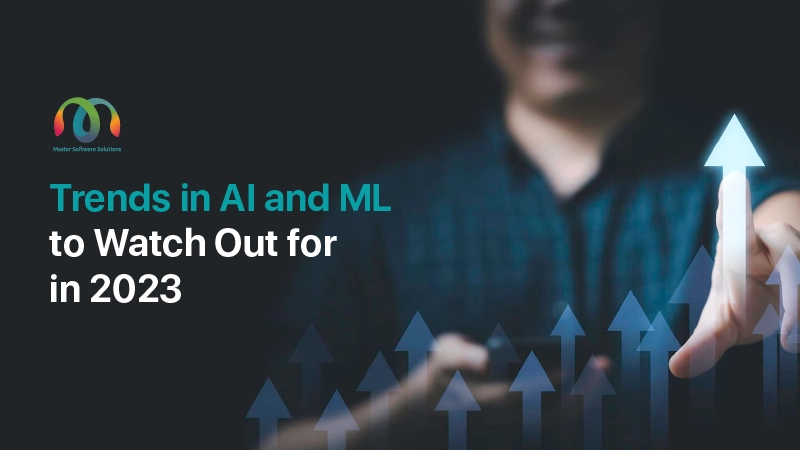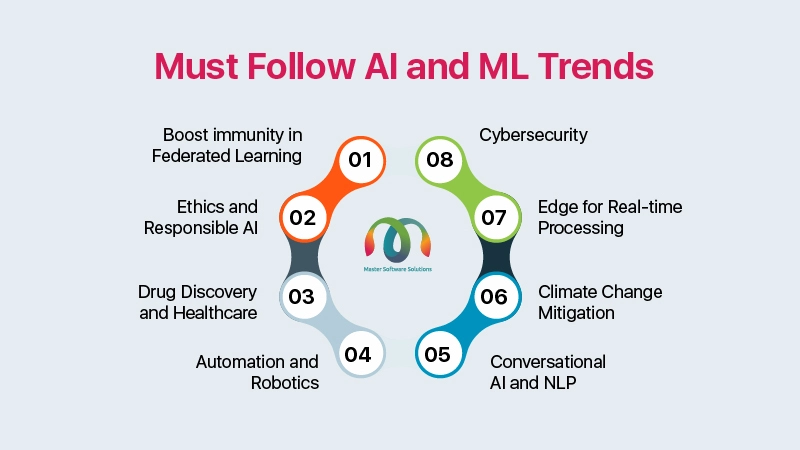Trends in AI and ML to Watch Out for in 2023

Artificial intelligence (AI) and Machine Learning (ML) have seen tremendous progress and innovation in recent years. These technologies will continue to evolve at an unprecedented rate as we approach 2023, altering businesses and communities.
A Fortune Business Insight report predicted that investment in machine learning would reach $209.91 billion by 2029.
ChatGPT stands out among these breakthroughs as a prime example of how AI and ML can revolutionise human-machine conversations, providing a look into a future when seamless and meaningful interactions with machines are a reality.
This blog delves into the interesting trends in AI and ML that are expected to dominate this year and have a long-term influence on a variety of industries.
Must follow AI and ML trends
Boost immunity in federated learning
Federated learning refers to a technology that allows models to be trained on a decentralised device while keeping the data localised at the same time. This trend is expected to protect data security and accelerate AI research in fields like healthcare (patient data) and finance (account information). Since there is no transfer of data, a large amount of datasets can be incorporated into the technology.
Ethics and responsible AI
AI has become a new normal in our daily lives, and there is a greater emphasis on ethics in AI. Ethics and AI responsibility ensure that models are transparent, fair, and accountable. It makes sure that sensitive data and customer information are not used illegally or unethically, offering security and restricting access to data based on individual requirements and usage. It removes organisational biases and errors, ensuring that uniformity and awareness are integrated into the AI model.
Drug discovery and healthcare
AI and ML are expected to play a crucial role in drug discovery which will revolutionise the healthcare industry. The algorithm of ML in drug discovery and healthcare is able to analyse the datasets in health find prospective medication candidates and predict the patient’s results. Using past data and analysing the patterns it can detect how efficiently is the drung working on the patients.
Computer vision
According to a McKinsey Report, “by 2024, AI-driven speech, written word, or computer-vision algorithms will augment more than 50% of user touches.” Computer vision AI research teaches computers to extract and understand images and movies. It employs ML since your phone recognises your face to unlock it. In healthcare, this technology is used to obtain pictures and extract data. AI may be taught to detect stones in CT scans.
Automation and robotics
AI robots use various technologies like machine learning, computer vision, etc. These robots are trained in such a way that they perform a specific, repetitive task. For example, in logistics. This has greatly improved efficiency across industries. These AI robots will change the entire way jobs were done before in industries ranging from manufacturing and logistics to agriculture and healthcare.

Conversational AI and NLP
Conversational AI includes chatbots and virtual assistants that, along with Natural Language Processing (NLP), give a natural response that seems more human. Using natural language processing integrated with conversational AI changes the way customers engage with businesses, which is expected to grow more advanced by 2023, allowing more natural and context-aware dialogues. The model has an impact on the customer service offered by the business, content creation, translation, and other areas.
Climate change mitigation
The growing concern about climate change has made it crucial to find novel solutions. Using AI is expected to play a critical role in 2023 in climate modelling, resource optimisation, and sustainable practices. The algorithms used in AI and ML can analyse environmental data and detect patterns to recommend solutions for mitigating the impact of climate change.
Edge for real-time processing
Edge computing processes data near its source, unlike traditional cloud computing, which makes real-time processing possible. Filtering the data at the edge allows relevant information to get transmitted into the cloud, allowing data processing in real-time. This model is used in IoT devices and sensors for low-latency applications for driverless vehicles and remote monitoring systems.
Cybersecurity
AI algorithms can detect patterns for potential cyberattacks and improve cybersecurity defences. Artificial intelligence (AI) is expected to play a crucial role in detecting cyber abnormalities, and breaches and protecting sensitive data from hackers.
From advances in privacy-preserving technology and ethical issues to transformations in healthcare and automation, trends in AI and ML are poised to reshape industries and improve the quality of life for people. 2023 promises to be the year of extraordinary growth and innovation in the disciplines of artificial intelligence (AI) and machine learning (ML).
Keeping an eye on these trends and following them provides insights into the fascinating possibilities that lie ahead of AI and ML. Book a meeting with our experts to learn more about how we can help your business with AI and ML.
